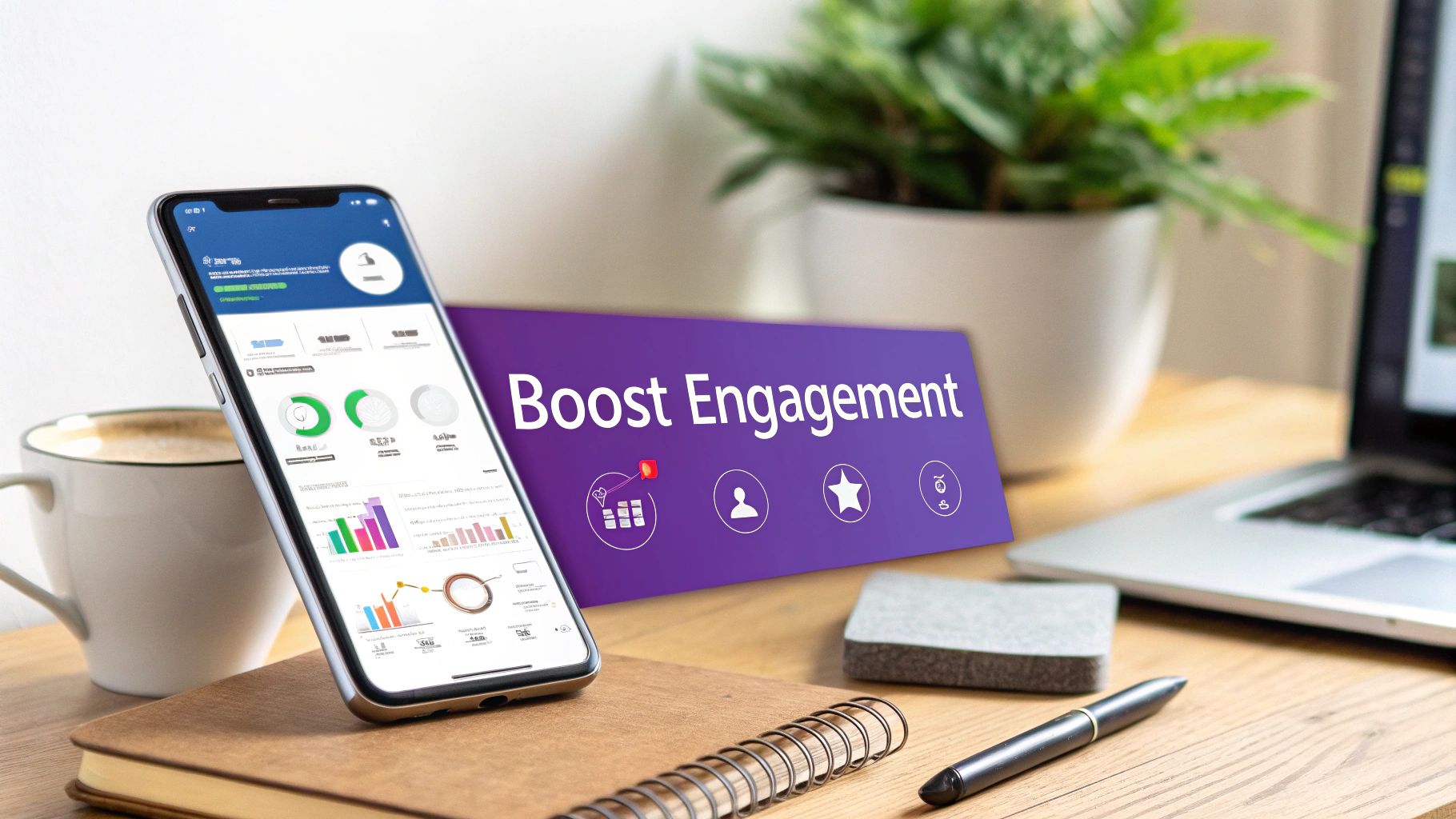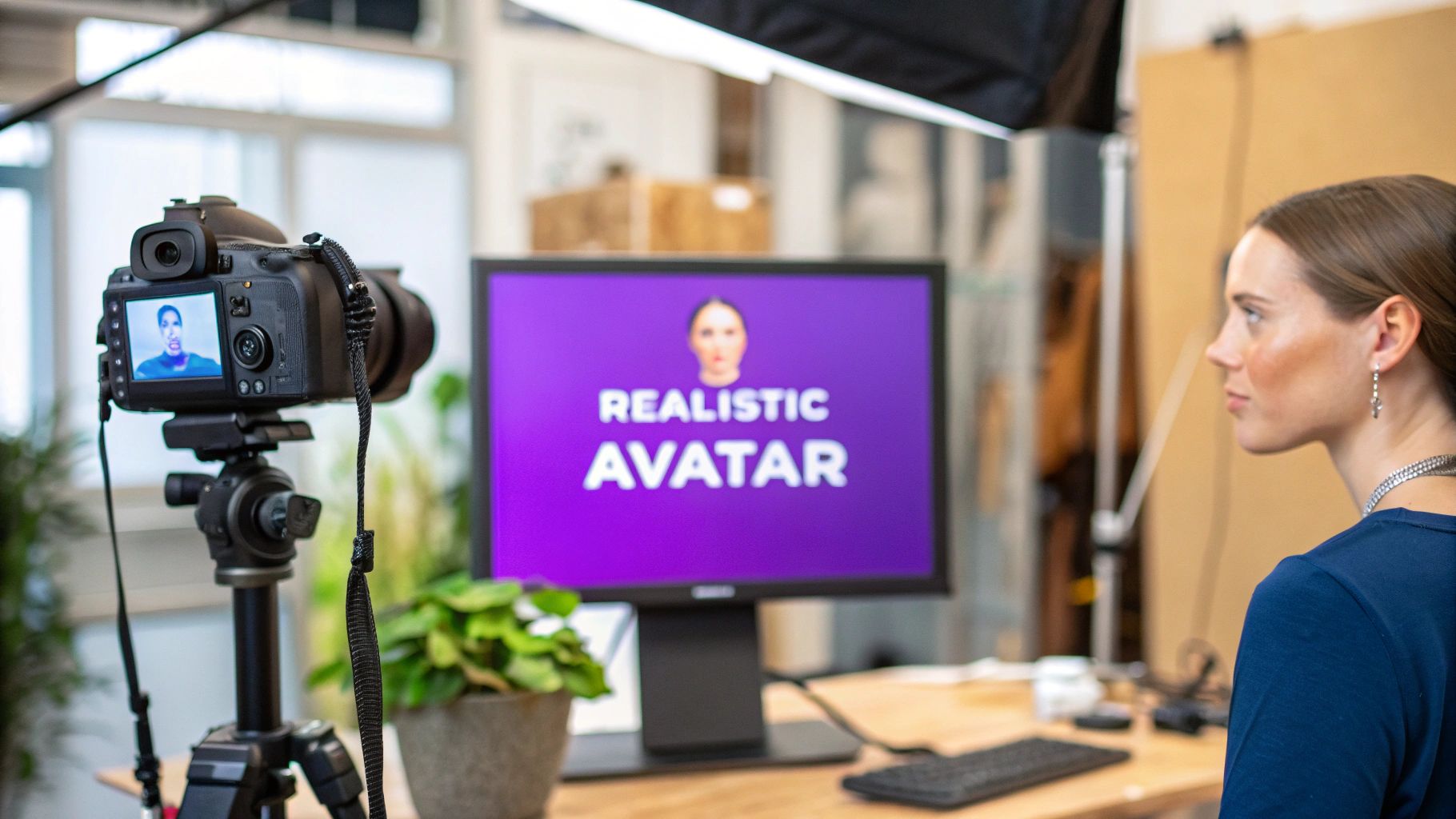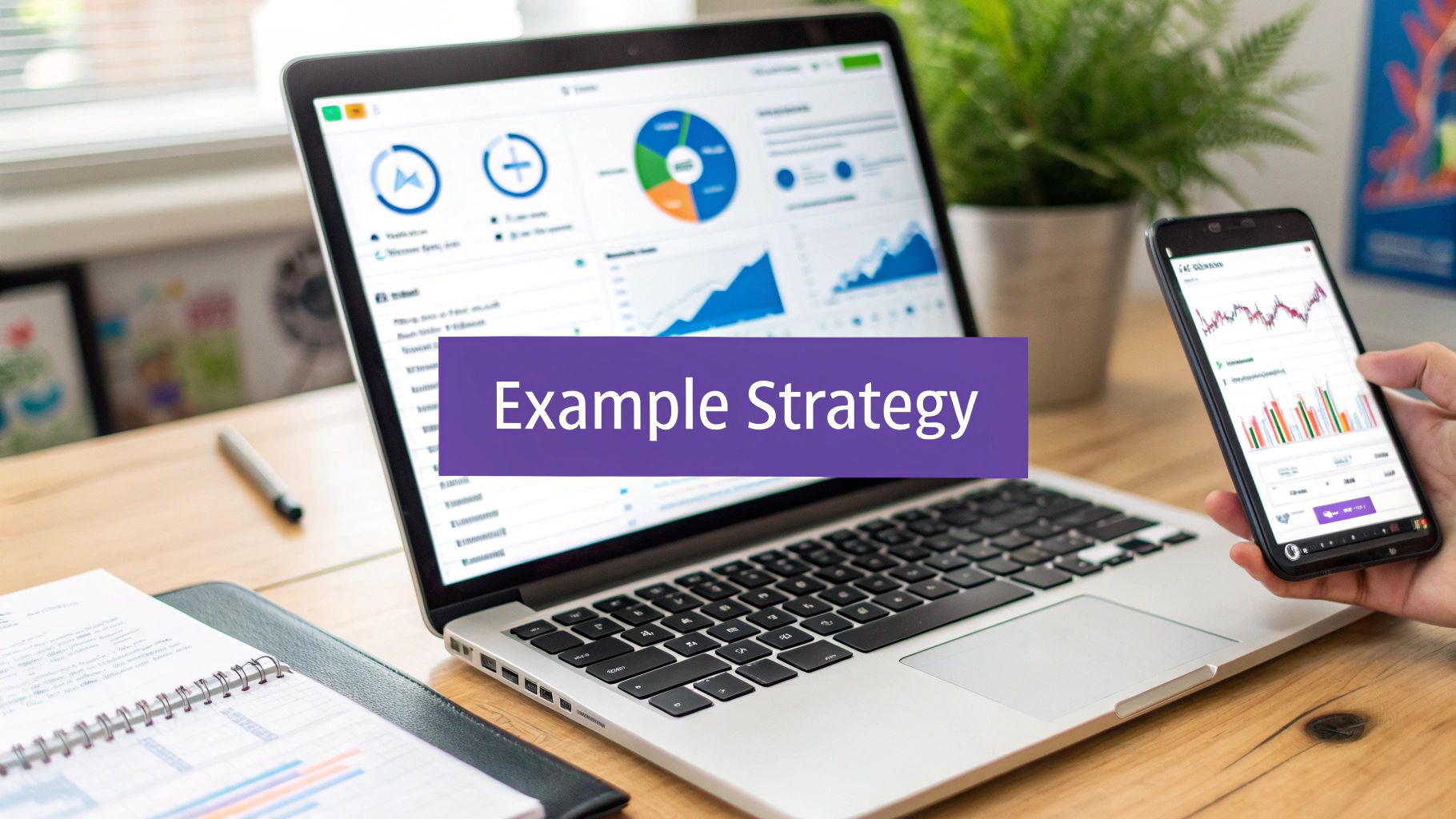9 AI-Powered Content Repurposing Strategies for 2025
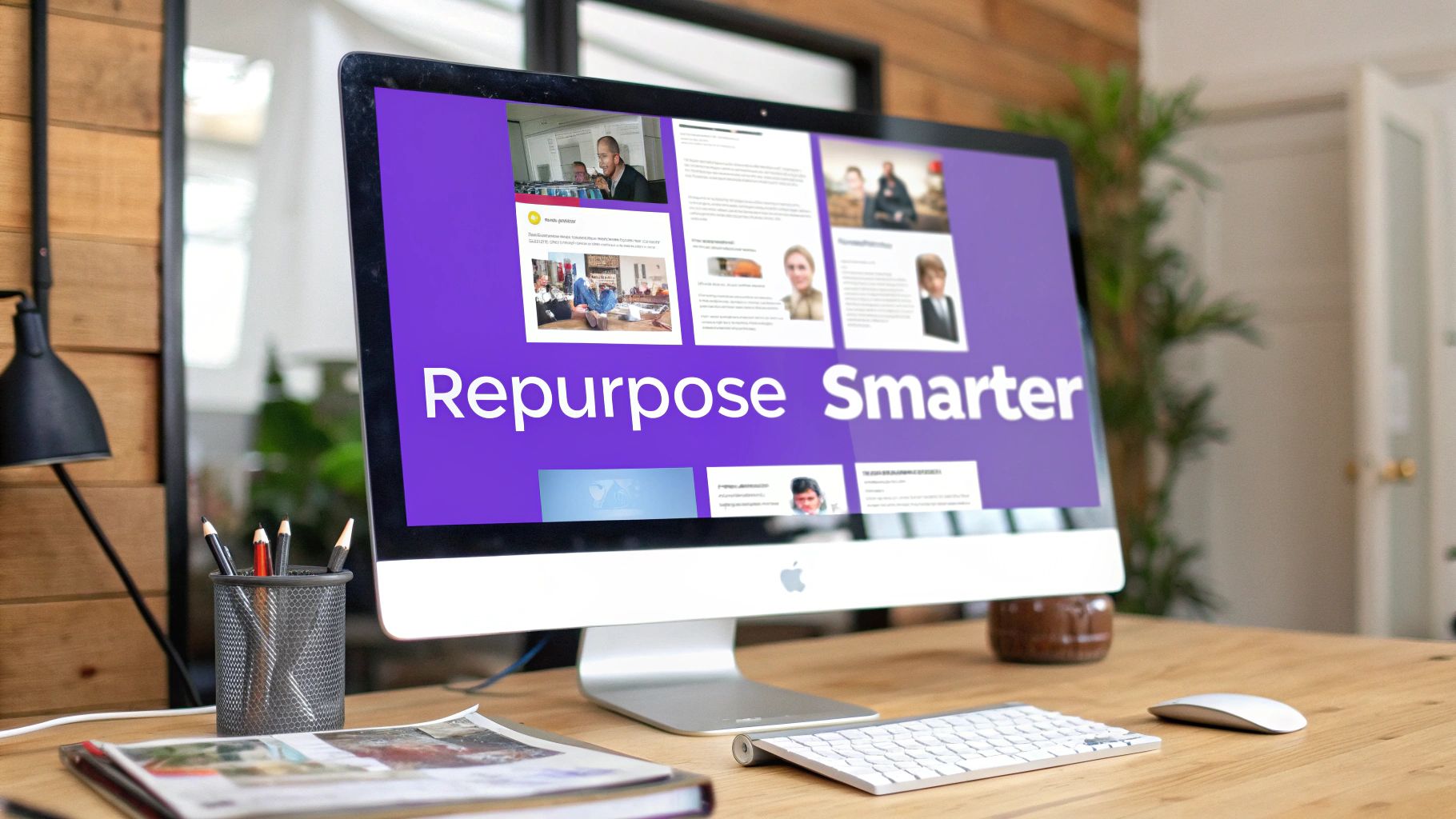
In today's saturated digital landscape, creating great content is only half the battle. The real challenge is making that content work harder for you, reaching diverse audiences across multiple platforms without burning out your team. This is where smart content repurposing strategies come into play, transforming a single piece of work into a versatile arsenal of assets. It’s no longer about simply creating more; it's about being more strategic with what you already have.
By repurposing, you maximize your return on investment, reinforce your core message, and cater to different consumption habits, from readers who love in-depth articles to viewers who prefer quick video clips. This guide moves beyond generic advice to present a concrete framework for effective content multiplication.
You will learn nine advanced, actionable strategies designed for modern marketing needs. We'll explore how to break down long-form content, transform text into engaging visuals, and leverage AI-driven tools to automate and optimize the entire process. These methods will ensure your best ideas gain the visibility and impact they truly deserve across the entire web. Let's dive into how you can amplify your reach without multiplying your workload.
1. Cross-Platform Content Adaptation: The Art of Native Translation
Effective content repurposing is more than a simple copy-paste job; it's about translating your core message for the unique culture of each digital platform. This strategy, "Cross-Platform Content Adaptation," involves deconstructing a primary piece of content and reassembling it into formats that feel native to different channels. This approach ensures your message not only reaches a wider audience but also resonates deeply by respecting each platform's distinct user expectations and algorithms.

Think of a detailed, 2,000-word blog post. Instead of just sharing the link everywhere, you adapt its essence. For LinkedIn, you might extract a key professional insight and expand it into a thoughtful article. For Instagram, you could transform the main data points into a visually striking carousel. That same core idea then becomes a rapid-fire, engaging thread on X (formerly Twitter). This method is one of the most powerful content repurposing strategies because it maximizes impact without diluting the original value.
How to Implement Native Translation
- Deconstruct Core Assets: Start with a "pillar" piece of content like a webinar, research report, or in-depth article. Identify the main arguments, key statistics, and powerful quotes.
- Map to Platform Strengths: Match each component to the ideal platform. A compelling customer story is perfect for a video Reel, while a complex statistic works well in a detailed LinkedIn post.
- Create Platform Templates: Design reusable templates in tools like Canva or Figma for each channel (e.g., Instagram carousel, X thread format, LinkedIn article banner). This speeds up the creation process while maintaining brand consistency.
- Adapt Tone and Voice: While your brand voice should remain consistent, your tone can shift. Be professional on LinkedIn, conversational on X, and inspirational on Instagram.
2. Long-Form to Micro-Content Breakdown
This strategy transforms extensive, in-depth content into smaller, easily digestible pieces for today's fast-scrolling audiences. "Long-Form to Micro-Content Breakdown" focuses on atomizing a single pillar asset, like a webinar or a detailed guide, into numerous bite-sized formats. This approach captures the attention of users who may not have the time to engage with the full-length original but are receptive to quick, high-value insights delivered on their preferred social platforms.
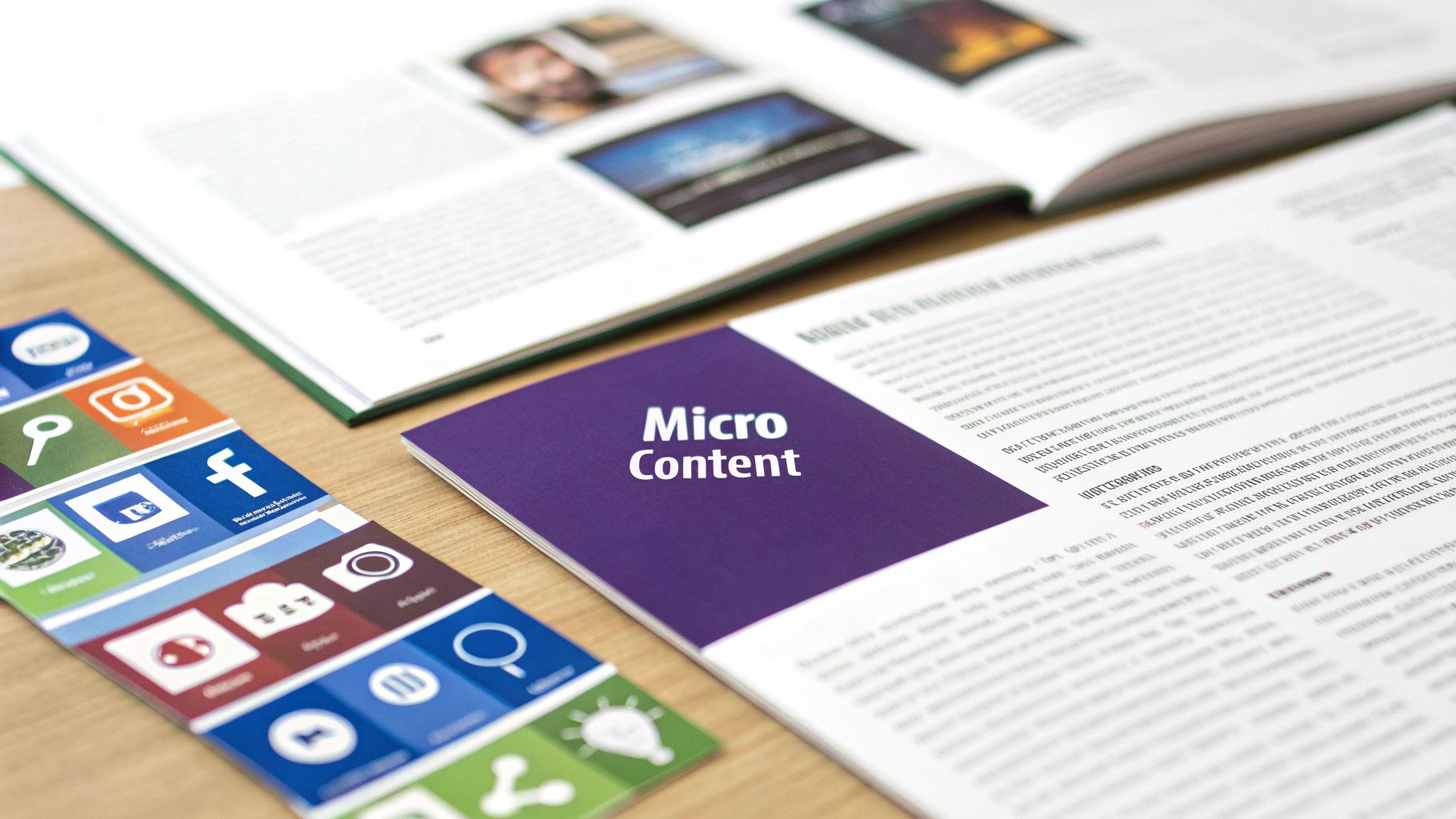
Consider how a brand like Shopify converts its comprehensive e-commerce guides into a multi-slide Instagram story series, or how TED repackages profound 18-minute talks into compelling 30-second reels. Similarly, a single podcast episode can be deconstructed into a series of shareable quote cards for Instagram, an insightful Twitter thread, and a short video clip for TikTok. This is one of the most efficient content repurposing strategies because it allows you to extract maximum value from your most resource-intensive work, driving traffic back to the original source.
How to Implement Micro-Content Breakdown
- Identify Key Takeaways: Review your pillar content and isolate 3-5 core messages, powerful statistics, or memorable quotes. These will become the foundation for your micro-content.
- Create Visual Templates: Use tools like Canva or Adobe Creative Suite to design branded, reusable templates for different micro-formats, such as quote graphics, video clips, and audiograms.
- Match Snippet to Platform: Tailor each micro-piece to the platform's strengths. A provocative question works well as a text-based X post, while a step-by-step tip is perfect for an Instagram Reel or a YouTube Short.
- Include a Clear Call-to-Action: Always guide your audience back to the original asset. Use phrases like "Watch the full webinar" or "Read the complete guide" with a direct link to drive deeper engagement.
3. Audio-Visual Format Transformation
This strategy revolves around converting content from one sensory format to another, primarily between audio and visual mediums. It acknowledges that audiences consume information differently; some prefer listening during a commute, while others engage more with visual storytelling. By transforming a podcast into a YouTube video or a detailed article into an infographic, you cater to these diverse preferences and capture attention across a wider spectrum of platforms and situations.

Consider how a single audio-only podcast episode can be repurposed. Its full-length recording can be uploaded to YouTube with a branded static image or dynamic audiogram. Short, impactful clips from that same episode can become viral Shorts or Reels, attracting a new audience segment. This is one of the most effective content repurposing strategies because it taps into the massive user bases of both audio-first platforms like Spotify and video-first platforms like YouTube and TikTok, essentially doubling the potential reach of a single recording.
How to Implement Audio-Visual Transformation
- Prioritize High-Quality Source Material: Start with crystal-clear audio. Poor sound quality will make any video or audio clip unappealing. Investing in a good microphone is non-negotiable for this strategy.
- Leverage Transcription and Subtitles: Use AI-powered transcription services to create a written version of your audio. This can become a blog post, and the transcript can be used to generate accurate captions for video clips, boosting accessibility and engagement.
- Create Branded Visual Assets: Develop a consistent visual identity for your video content. This includes creating templates for audiograms, video thumbnails, and end screens that align with your brand, making your content instantly recognizable.
- Optimize for Platform-Specific Formats: A full-length YouTube video has different requirements than a 60-second TikTok. Edit and format your content specifically for each platform, paying attention to aspect ratios, length, and common user behaviors.
4. Series and Sequential Content Development
Instead of treating a large content asset as a one-time release, this strategy transforms it into an ongoing series that builds anticipation and fosters long-term audience engagement. Series and Sequential Content Development involves breaking down a substantial topic, like a comprehensive guide or an extensive research report, into smaller, interconnected installments. This encourages your audience to return week after week, creating a loyal following invested in the complete narrative.

Imagine you have an ultimate guide to SEO. Rather than publishing a single, massive article, you can serialize it. Week one could cover keyword research, week two on-page optimization, and week three link-building. Each piece stands on its own while contributing to a larger, more valuable whole. This is one of the most effective content repurposing strategies for building authority and habituating your audience to your publishing schedule, as famously demonstrated by Moz with their "Whiteboard Friday" video series.
How to Implement a Content Series
- Plan the Entire Arc: Before publishing the first installment, map out the full series. Define each topic, its key takeaways, and how it connects to the next episode to ensure a cohesive narrative flow.
- Create Compelling Titles: Use titles that clearly indicate progression (e.g., "Part 1: The Foundation," "Step 2: Advanced Techniques"). This sets expectations and helps users navigate the series.
- Maintain Consistent Branding: Use a consistent visual identity, format, and tone for every piece in the series. This includes creating a unique logo or banner that immediately signals it's part of the sequence.
- Include Recaps and Teasers: Start each new piece with a brief recap of the previous one and end with a teaser for what's coming next. This reinforces learning and builds excitement for future content.
5. User-Generated Content Integration: Amplifying Your Brand Through Community
One of the most authentic and powerful content repurposing strategies is to leverage the voice of your audience. User-Generated Content (UGC) Integration involves transforming genuine customer experiences, testimonials, and creations into official brand assets. This approach shifts the spotlight from your marketing team to your community, building social proof, trust, and a powerful sense of belonging. It turns passive consumers into active brand advocates.
Think of GoPro, which built an empire by showcasing breathtaking videos filmed by its users. A single user's epic adventure video can be repurposed into a short, thrilling clip for TikTok, a high-resolution still image for an Instagram post, a customer success story on the blog, and featured footage in a larger compilation on YouTube. Similarly, Airbnb transforms guest stories and photos into compelling destination guides and social media campaigns. This method is incredibly effective because it provides a constant stream of genuine, relatable content that resonates far more deeply than polished corporate messaging.
How to Implement UGC Integration
- Launch Hashtag Campaigns: Create a unique and memorable hashtag to encourage users to share their experiences with your product or service. This organizes submissions and creates a trackable movement.
- Establish Clear Guidelines & Permissions: Always get explicit permission before repurposing someone's content. Create a clear submission process and terms of use to protect both your brand and your contributors.
- Curate and Showcase Relentlessly: Actively monitor your brand mentions and hashtags. Curate the best content that aligns perfectly with your brand's values and aesthetic, and showcase it prominently across your channels.
- Reward and Recognize Contributors: Acknowledge the creators. Tag them in your posts, offer them features on your website, or provide small incentives like discounts or merchandise. Recognition is a powerful motivator for continued participation.
6. Evergreen Content Updating and Refreshing: Revitalizing Your Core Assets
True evergreen content isn't a "set it and forget it" asset; it's a living document that requires periodic care. This strategy involves systematically updating and refreshing your most valuable, timeless content to maintain its accuracy, relevance, and search engine authority. Instead of creating new content from scratch, you enhance what already performs well, ensuring it continues to attract traffic and provide value long after its initial publication. This method keeps your best work at the peak of its power.
Think of a comprehensive guide to SEO from two years ago. While the core principles might hold, specific tactics, algorithm details, and tool recommendations have likely changed. By refreshing this guide with the latest statistics, updating screenshots, and adding new sections on emerging trends, you signal to both search engines and users that the information is current and trustworthy. This is one of the most efficient content repurposing strategies because it leverages existing search authority, like that seen in Backlinko's and HubSpot's annual content refreshes, to drive sustained results.
How to Implement Evergreen Refreshes
- Schedule a Content Audit: Set up a recurring schedule (quarterly or biannually) to review your top-performing evergreen content. Use analytics to identify pieces with high traffic but declining engagement or outdated information.
- Prioritize Based on Performance: Focus your efforts on content that already ranks well or has a high number of valuable backlinks. A small update to a page-one article often yields a greater ROI than overhauling a low-performing one.
- Enhance, Don't Erase: Add new sections, update statistics with current data, replace old examples, and embed new media like videos or infographics. Avoid completely rewriting the content to preserve its existing SEO value.
- Update and Promote: After making significant changes, update the "last modified" date and consider changing the publication date. Promote the refreshed piece to your email list and on social media as if it were new content.
7. Interactive Content Transformation
Static content informs, but interactive content engages. This strategy involves transforming passive assets like blog posts or guides into dynamic experiences such as quizzes, polls, or calculators. Instead of simply presenting information, you invite the user to participate, making the content more memorable and valuable. This approach shifts the user from a passive reader into an active participant, significantly boosting engagement and lead generation potential.
Imagine a comprehensive guide on "Choosing the Right Project Management Software." While the guide is useful, it can be repurposed into an interactive "What's Your Project Management Style?" quiz. BuzzFeed famously mastered this by turning lifestyle articles into viral personality quizzes. Similarly, a financial blog post detailing business startup costs can become a powerful business loan calculator, as seen with tools from Shopify. These content repurposing strategies are exceptionally effective because they provide personalized value in exchange for user attention and data.
How to Implement Interactive Transformation
- Identify Conversion Opportunities: Review your top-performing static content. Look for posts with checklists, step-by-step processes, or comparison data that can be logically converted into a quiz, assessment, or calculator.
- Choose the Right Tool: Utilize platforms like Typeform, Jotform, or Outgrow to build your interactive elements without needing to code. Start with simple formats like polls or basic quizzes to test audience reception.
- Embed and Promote: Seamlessly embed the interactive tool within the original blog post or on a dedicated landing page. Promote it as a new, valuable resource across your marketing channels.
- Provide Immediate Value: Ensure the user receives instant results or a useful outcome upon completion. Follow up with a clear call-to-action, such as downloading a related guide or signing up for a newsletter.
- Gather Data Ethically: If you collect user data, be transparent about how it will be used. A simple disclaimer can build trust and ensure compliance with privacy regulations.
8. Community and Discussion-Based Repurposing
Your audience is one of your most valuable content creation engines. This strategy involves transforming the organic conversations, questions, and insights happening in your community into standalone content pieces. By listening to your audience's engagement on platforms like Reddit, Discord, or LinkedIn comment sections, you can generate content that is guaranteed to resonate because it comes directly from their interests and pain points. This approach not only fuels your content calendar but also strengthens community bonds by showing members they are heard.
Imagine a lively comment thread on one of your LinkedIn posts where users debate a new industry trend. You can gather the most insightful comments and expand on them in a comprehensive blog post, crediting the contributors. Similarly, a popular Reddit AMA (Ask Me Anything) can be transcribed and edited into a Q&A article, while a recurring question in your Facebook group could become the topic for your next podcast episode. This is one of the most authentic content repurposing strategies because it places your community at the center of your content creation process.
How to Implement Community-Based Repurposing
- Monitor Your Channels: Actively track conversations in your social media comments, Discord server, Reddit communities, and Facebook groups. Look for recurring questions, heated debates, or brilliant insights.
- Source and Credit: When you spot a golden nugget of a comment or question, reach out to the user and ask for permission to feature their idea. Always give credit, which encourages more participation.
- Develop a Content Series: Create a regular feature like a "Community Q&A" blog post, a "Comment of the Week" social media graphic, or a monthly podcast episode dedicated to discussing topics raised by your audience.
- Spark Deliberate Conversations: Don't just wait for conversations to happen. Post thought-provoking questions and polls specifically designed to generate discussion that you can later repurpose into valuable content.
9. Data-Driven Content Multiplication
Turning raw data into a compelling narrative is a cornerstone of modern marketing, and "Data-Driven Content Multiplication" is the strategy that makes it possible. This approach involves taking a single, authoritative data source, like a research report or analytics study, and atomizing it into a multitude of content assets. Instead of publishing one report and hoping for the best, you strategically unpack its findings into formats tailored for different audiences and platforms, from insightful infographics to snackable social media posts.
Think of HubSpot's annual marketing benchmarks data or Hootsuite's social media trend reports. These companies don't just release a PDF; they transform that data into an entire campaign. A single statistic becomes a visually engaging Instagram post, a key trend becomes a LinkedIn article, and the entire dataset is visualized in a detailed infographic shared via a blog post. This is one of the most effective content repurposing strategies because it establishes authority and generates a continuous stream of high-value, evidence-based content from a single research effort.
How to Implement Data-Driven Multiplication
- Invest in a Strong Data Source: Start with original research, a comprehensive customer survey, or an in-depth analysis of proprietary data. This foundational asset is the engine for all subsequent content.
- Create Multiple Visualizations: A single dataset can be visualized in countless ways. Create pie charts, bar graphs, heat maps, and infographics to represent different findings. Each visual can become its own standalone content piece.
- Develop High-Level and Detailed Content: Cater to different levels of interest. Create high-level summaries and key takeaways for social media and email newsletters, while reserving deep-dive analyses and full reports for your blog or a gated download.
- Time Releases Strategically: Align the release of your data-driven content with relevant industry events, holidays, or seasonal trends to maximize its timeliness and impact. For instance, release a report on e-commerce trends just before Black Friday.
Content Repurposing Strategies Comparison
| Strategy | Implementation Complexity 🔄 | Resource Requirements ⚡ | Expected Outcomes 📊 | Ideal Use Cases 💡 | Key Advantages ⭐ |
|---|---|---|---|---|---|
| Cross-Platform Content Adaptation | High – Requires deep platform knowledge | Medium to High – Time-intensive adaptation | Maximizes reach & ROI across multiple platforms | Brands targeting diverse audiences on multiple channels | Leverages platform strengths; audience segmentation |
| Long-Form to Micro-Content Breakdown | Medium – Extracting key insights carefully | Medium – Design and editing tools needed | Increases consumption & shareability of content | Busy audiences preferring quick, easy-to-digest info | Fits social media algorithms; drives traffic to originals |
| Audio-Visual Format Transformation | High – Technical skills and tools required | High – Video/audio editing and transcription | Expands accessibility; enhances engagement | Catering to diverse learning/consumption preferences | Multiformat SEO benefits; broadens platform use |
| Series and Sequential Content Development | Medium to High – Needs long-term planning | Medium – Consistent content production | Builds loyalty and repeat visits over time | Educational, storytelling, or thematic content | Deep topic exploration; audience retention |
| User-Generated Content Integration | Medium – Managing permissions and quality | Low to Medium – Relies on community input | Builds trust and authenticity; increases engagement | Brands with active user communities | Cost-effective; provides social proof |
| Evergreen Content Updating and Refreshing | Medium – Requires ongoing audits | Medium – Research and updates required | Maintains relevance & SEO rankings over time | Evergreen content needing sustained performance | Extends content lifespan; cost-effective |
| Interactive Content Transformation | High – Technical development skills needed | High – Production and maintenance costs | Significantly higher engagement and data collection | Brands wanting differentiated, participatory content | Improves memorability; encourages social sharing |
| Community and Discussion-Based Repurposing | Medium – Active community management | Low to Medium – Monitoring and curation | Creates relevant content; strengthens community ties | Communities with high user interaction | Endless content ideas; increases audience investment |
| Data-Driven Content Multiplication | High – Requires data expertise and tools | High – Data analysis and visualization | Positions brand as authority; creates shareable data | Brands leveraging unique data for thought leadership | Supports SEO; enables multiple content formats |
Unlocking Your Content's Full Potential
Content repurposing is no longer an optional tactic; it's a core component of a resilient and efficient marketing engine. As we've explored, moving beyond a linear 'create and publish' mindset to a cyclical 'create, amplify, and reinvent' model is essential for modern creators and brands. Each piece of content you produce is a seed with the potential to grow into a diverse ecosystem of assets, each designed to engage different audience segments in the formats they prefer. The nine distinct content repurposing strategies detailed in this guide provide a comprehensive framework for achieving this.
From breaking down long-form articles into micro-content for social media to transforming data-driven reports into compelling infographics, the possibilities are vast. Mastering these approaches means you are no longer a content creator on a treadmill, constantly chasing the next new idea. Instead, you become a strategic architect, building a library of interconnected assets that work synergistically to enhance your brand's reach and authority.
From Strategy to System: Your Actionable Next Steps
The key to sustainable success is building a system. Don't let these ideas remain abstract concepts; put them into practice with a clear plan.
- Start with an Audit: Begin by reviewing your existing content library. Identify your high-performing "pillar" pieces, such as comprehensive blog posts, popular videos, or detailed case studies. These are your prime candidates for repurposing.
- Identify Opportunities: For each pillar piece, map out potential new formats. Could that webinar become an audio podcast? Can that customer success story be turned into a series of quote graphics for Instagram?
- Integrate AI-Powered Tools: Leverage technology to streamline the execution. This is where the real efficiency gains are found. Platforms like MakerBox are instrumental here, using AI to instantly generate platform-optimized social media content, professional bios, and stunning visuals directly from your core ideas. This automation frees up your valuable time to focus on high-level strategy rather than tedious manual adaptation.
By systematically integrating these content repurposing strategies into your workflow, you can dramatically increase your content output, boost audience engagement, and solidify your brand's authority across multiple channels. The true value lies not just in saving time, but in maximizing the impact and lifespan of every single piece of content you create. You stop working harder and start working smarter, ensuring your best ideas reach the widest possible audience without exponentially increasing your budget or workload.
Ready to put these strategies into action and reclaim your time? Start by automating your content adaptation with MakerBox. Use its powerful AI tools to instantly transform your core content into a month's worth of platform-perfect posts, bios, and visuals, so you can focus on what matters most. Explore what MakerBox can do for your content workflow today.


